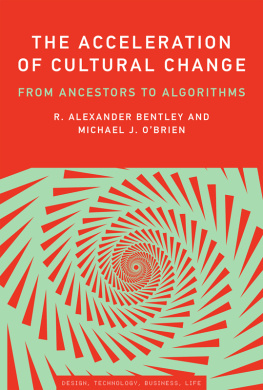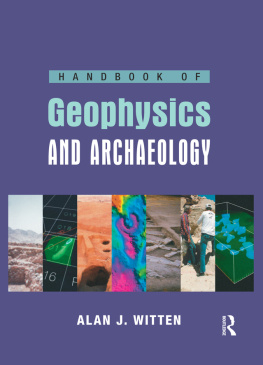Handbook of
Archaeological Theories
Handbook of
Archaeological Theories
EDITED BY
R. ALEXANDER BENTLEY,
HERBERT D. G. MASCHNER,
AND CHRISTOPHER CHIPPINDALE

ALTAMIRA PRESS
A division of Rowman & Littlefield Publishers, Inc.
A wholly owned subsidiary of The Rowman & Littlefield Publishing Group, Inc.
4501 Forbes Boulevard, Suite 200, Lanham, MD 20706
www.altamirapress.com
Estover Road, Plymouth PL6 7PY, United Kingdom
Copyright 2008 by AltaMira Press
First paperback edition 2009
All rights reserved. No part of this publication may be reproduced, stored in a retrieval system, or transmitted in any form or by any means, electronic, mechanical, photocopying, recording, or otherwise, without the prior permission of the publisher.
British Library Cataloguing in Publication Information Available
Library of Congress Cataloguing-in-Publication Data
Handbook of archaeological theories / edited by R. Alexander Bentley, Herbert D. G. Maschner, and Christopher Chippindale.
p. cm.
Includes bibliographical references and index.
1. ArchaeologyPhilosophyHandbooks, manuals, etc. I. Bentley, R. Alexander, 1970 II. Maschner, Herbert D. G. III. Chippindale, Christopher, 1951
CC72.H36 2008
930.1019dc22
2006102103
ISBN: 978-0-7591-0032-9 (cloth : alk. paper)
ISBN: 978-0-7591-0033-6 (pbk. : alk. paper)
ISBN: 978-0-7591-1360-2 (electronic)
Printed in the United States of America
 The paper used in this publication meets the minimum requirements of American National Standard for Information SciencesPermanence of Paper for Printed Library Materials, ANSI/NISO Z39.481992.
The paper used in this publication meets the minimum requirements of American National Standard for Information SciencesPermanence of Paper for Printed Library Materials, ANSI/NISO Z39.481992.
Contents
| R. Alexander Bentley and Herbert D. G. Maschner |
| Gary S. Webster |
| Patty Jo Watson |
| David R. Yesner |
| David W. J. Gill |
| Randall H. McGuire |
| Andrew Gardner |
| R. Alexander Bentley, Carl Lipo, Herbert D. G. Maschner, and Ben Marler |
| Michael Shanks |
| John Bintliff |
| Tom D. Dillehay |
| Timothy Earle |
| Mark Collard, Stephen Shennan, Briggs Buchanan, and R. Alexander Bentley |
| Peter Bellwood |
| R. Alexander Bentley and Herbert D. G. Maschner |
| Andre Costopoulos |
| Liane Gabora |
| Timothy Taylor |
| Sin Jones |
| Kelley Ann Hays-Gilpin |
| Stephanie Koerner and Steven Price |
| Thomas J. Green |
| Gillian Wallace |
| Don D. Fowler, Edward A. Jolie, and Marion W. Salter |
| Ian J. McNiven and Lynette Russell |
| Peter Jordan |
| Mark Pluciennik and Marek Zvelebil |
| Kenneth M. Ames |
| Alex W. Barker |
| Reinhard Bernbeck |
| David S. Whitley |
CHAPTER 1
Introduction: On Archaeological Theories
R. ALEXANDER BENTLEY AND HERBERT D. G. MASCHNER
THEORY IS ONE of the most hotly debated topics in the field of archaeology. Peruse the journals and major publishing concerns since the mid-1960s and you will find that some of the most cited papers and books are statements or reviews of archaeological theory. Yet major advances in archaeological theory have been made by remarkably few people. When one thinks of names that might be included this book, such notables as Childe, Taylor, Binford, Flannery, Watson (this volume), and Schiffer come to mind. A younger generation certainly includes Hodder, Shanks (this volume), Conkey, OBrien, Tilley, Ames (this volume), Hegmon, Shennan, Crumley, and a number of others who have made a large impact on specific aspects of archaeology ranging from gender to rock art. These names, and the others represented in this volume, are a tiny percentage of those who consider themselves archaeologists. The rest of the field looks to these writers to help explain data, to understand and present the past, and to make it interesting and useful.
Ironically, the competition among the creators of archaeological theories for followers to apply them (Bintliff, ; OBrien et al. 2005:chap. 9) makes the theories less applicable, as the debate itself becomes the topic, even to a debate over what the current theoretical disagreements actually are (Hegmon 2003, 2005; Moss 2005). This induces the dialogue to become fashion rather than true theory, which the dictionary defines as a set of statements or principles devised to explain a group of facts or phenomena, especially one that has been repeatedly tested or is widely accepted and can be used to make predictions about natural phenomena or a plausible or scientifically acceptable general principle or body of principles offered to explain natural phenomena.
The constant advance of fashionable change is one reason why earlier efforts to build true scientific theory in archaeology (Watson, LeBlanc, and Redman 1974; Schiffer 1976) have already been discarded in many quarters. Instead, nearly all archaeological theory can be best defined as methods of interpretation, explanation, or critique, but not as theory. Equally interesting, much of the literature since the early 1980s arguing for archaeological theories based on reflexivity, critique, interpretation, and post-processualism is written as antitheory in its avoidance of prediction, generalizing principles, and testability. While these approaches may be theoretical, the only theories we have in archaeology that actually fit the definition of theory are Darwinism, Marxism, and certain aspects of processualism because they describe a set of propositions and expectations about how the world should work that are testable against the archaeological record. This is the reason why the Marxist explanations of Childe often identify him as one of the first theoretical archaeologists, while all those who went before are seen as placing archaeological data in the explanatory framework of their times, such as biblical explanations for an ancient past.
Whereas archaeological theory should fit the explicit model of scientific inquiry, theoretical discussion of archaeology opens up the field to comment, revisionism, and critique from sources ranging from philosophy to feminism to culture studies. Taking theory and theoretical critique together, almost anything becomes possible with archaeology. Consider other topics or disciplines, like law, agricultural science, photography, chemistry, medicine, or industrial relations; how many of them can be defined simultaneously as science, art, social study, tactical landscape work, mindless manual labor, abstract theory, objective data collection, and vehicle for personal introspection? Archaeology attracts scholars from an endless range of backgrounds, and they all have a different reason for pursuing it. One of us (Bentley) entered archaeology after earning an undergraduate degree in physics, with a research assistantship doing neutron activation analysis on Etruscan pottery (blasting pots, as friends called it). The other (Maschner) once considered a scholarship in opera before deciding on archaeology instead. Despite the countless ways of getting involved, the












 The paper used in this publication meets the minimum requirements of American National Standard for Information SciencesPermanence of Paper for Printed Library Materials, ANSI/NISO Z39.481992.
The paper used in this publication meets the minimum requirements of American National Standard for Information SciencesPermanence of Paper for Printed Library Materials, ANSI/NISO Z39.481992.